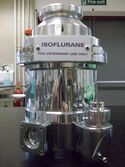Vaporisers
| This article is still under construction. |
Introduction
A vaporiser delivers safe and effective concentrations of anaesthetic vapour and are commonly found on the back bar of an anaesthetic machine. As most inhalation agents are stored as liquids at room temperature, there is a requirement for them to be vapourised before reaching the patient. Safe concentrations are achieved by the stream of fresh gas being split as it reaches the vapouriser causing some of it to pass through the vaporiser chamber containing the saturated vapour, while the remaining gas bypasses this meaning that the vapour is diluted down making it safe for the patient to breathe.
- Plenum vaporisers have the gas flowing through them under positive pressure where the gas is delivered from flowmeters proximal to it on the anaesthetic machine. They are the most common type and fitted to the backbar of the machine.
- Down-over vaporisers have the gas flowing through them under negative pressure developed distal to it, generated by the patient's inspiration. They have low resistance to gas flow and are usually used 'in-circuit'.
The amount of anaesthetic vaporised depends on a number of factors :-
- The saturated vapour pressure (SVP) of the agent.
- Temperature.
- Gas flow.
- Contact between gas and agent.
- Vaporiser dimensions
- Movement of the vapouriser
- Back pressure
Plenum Vaporisers
Temperature Compensated (TEC) Vaporisers
These vaporisers prevent the fall in vapour that may otherwise occur as evaporation and cooling of the liquid. This is achieved by changing the splitting ratio with temperature, so that as temperature falls more gas flows through. TEC vaporisers are used for Isoflurane.
Measured Flow Vaporisers
These vaporisers are used for Desflurane, as it has a very low boiling point and would not stay as a liquid in conventional vaporisers. These vaporises are electrically heated to maintain the agent chamber at a constant temperature allowing the agent to remain liquified.
To prevent the incorrect agent being used in the incorrect vaporiser a key-indexed filling system has been designed so that each agent has a specific key that will only fit in the appropriate vaporiser. Sevoflurane and desflurane are sold such that the bottles will only fit into the filler ports on the appropriate vaporiser.
Position of vaporisers on the backbar is important, especially if there is more then one vaporiser present. The more volatile anaesthetic agent should be places closer to the flowmeter.
Vapouriser In-Circuit Machines
Komesaroff and Stephens' anaesthetic machines are both examples of a vapouriser in-circuit machine. They are essentially a circle breathing system with one or more draw-over vapourisers within the circuit. They are economical due to very low required gas flows but disadvantages include possible overdosing and performance of vapouriser may be contaminated by water vapour.
